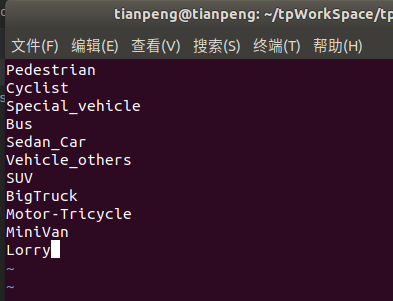目录
-
代码下载
-
更改配置及编译
-
测试初始权重
-
准备自己的数据集
-
划分测试集和训练集
-
将voc文件格式转为yolo文件格式(xml->txt)
-
训练
-
测试
1 代码下载
首先把代码下载下来,可以用下面命令下载,也可以直接点击上面代码链接下载。
git clone https://github.com/AlexeyAB/darknet.git
2 更改配置及编译
如果需要使用GPU加速,那么得打开项目里面的makefile文件修改一些参数的值。修改完成之后在直接make。
GPU=1
CUDNN=1
CUDNN_HALF=1
OPENCV=1
OPENMP=1
LIBSO=1
DEBUG=1
编译:
make 或者 make -j8
3 测试初始权重
./darknet detect cfg/yolov4.cfg yolov4.weights data/dog.jpg
初始权重yolov4.weights需要下载。
4 准备自己的数据集
(1) 准备JPEGImages文件夹,里面存放要训练和测试的图像集。
(2)准备Annotations文件夹,里面存放标注好的voc格式的xml文件。
5 划分测试集和训练集
运行makeTxt.py脚本文件,在ImageSets文件夹里生成train.txt和test.txt文件,里面为去除后缀的图像名。
import os import random train_percent = 0.8 xmlfilepath = 'Annotations' txtsavepath = 'ImageSets' total_xml = os.listdir(xmlfilepath) num = len(total_xml) list = range(num) tr = int(num * train_percent) #trainval = random.sample(list, tv) train = random.sample(list, tr) if not os.path.exists('ImageSets/'): os.makedirs('ImageSets/') ftest = open('ImageSets/test.txt', 'w') ftrain = open('ImageSets/train.txt', 'w') for i in list: name = total_xml[i][:-4] + ' ' if i in train: ftrain.write(name) else: ftest.write(name) ftrain.close() ftest.close()
6 将VOC文件格式转为yolo文件格式
运行xml2txt.py文件,在当前目录生成tp_train.txt和tp_test.txt文件,里面存放训练和测试图像的绝对路径。且在labels文件夹下生成xml转txt格式的文件。
import xml.etree.ElementTree as ET import pickle import os from os import listdir, getcwd from os.path import join sets=[ 'train', 'test'] #替换为自己的数据集 classes = ["person", "car", "cyclist"] #修改为自己的类别 #classes = ["eye", "nose"] def convert(size, box): dw = 1./(size[0]) dh = 1./(size[1]) x = (box[0] + box[1])/2.0 - 1 y = (box[2] + box[3])/2.0 - 1 w = box[1] - box[0] h = box[3] - box[2] x = x*dw w = w*dw y = y*dh h = h*dh return (x,y,w,h) def convert_annotation(image_id): in_file = open('Annotations/%s.xml'%image_id) #将数据集放于当前目录下 out_file = open('labels/%s.txt'%image_id, 'w') tree=ET.parse(in_file) root = tree.getroot() size = root.find('size') w = int(size.find('width').text) h = int(size.find('height').text) for obj in root.iter('object'): difficult = obj.find('difficult').text cls = obj.find('name').text if cls not in classes or int(difficult)==1: continue cls_id = classes.index(cls) xmlbox = obj.find('bndbox') b = (float(xmlbox.find('xmin').text), float(xmlbox.find('xmax').text), float(xmlbox.find('ymin').text), float(xmlbox.find('ymax').text)) bb = convert((w,h), b) out_file.write(str(cls_id) + " " + " ".join([str(a) for a in bb]) + ' ') wd = getcwd()#获取当前目录 train_images_dir = os.path.join(wd, 'JPEGImages/') for image_set in sets: if not os.path.exists('labels/'): os.makedirs('labels/') image_ids = open('ImageSets/%s.txt'%image_set).read().strip().split() list_file = open('%s_%s.txt'%("tp", image_set), 'w') #reate new file store image path for image_id in image_ids: list_file.write(train_images_dir+'%s.jpg '%image_id) convert_annotation(image_id) list_file.close()
7 训练
7.1 修改配置文件yolov4.cfg
复制cfg/yolov4-custom.cfg,并且重命名为yolo-obj.cfg,同时修改一下内容

上图中修改width和height为416,修改最大batch迭代多少个数max_batches = 6000,修改steps多久学习率下降一次,一般设置为batch个数的80%和90%。 然后三个classes的地方和三个filters=255的地方要修改成自己的。
7.2 编辑adas.data 和 adas.names文件
(1)adas.data

classes :训练集类别总数
train:训练集路径
valid:验证集路径
names: adas.names 文件
backup: 备份文件夹,训练后的权重信息或者断点保存信息在此文件夹下。
(记得创建目录 backup)
(2)adas.name

根据自己要分类的名称编写,一行一个名字。
7.3 编写训练sh脚本
vim tp_train.sh

注:yolov4.conv.137预训练权重文件需要下载
执行 sh tp_train.sh 开始训练
8 测试
./darknet detector test cfg/obj.data cfg/yolo-obj.cfg yolo-obj_xxxx.weights